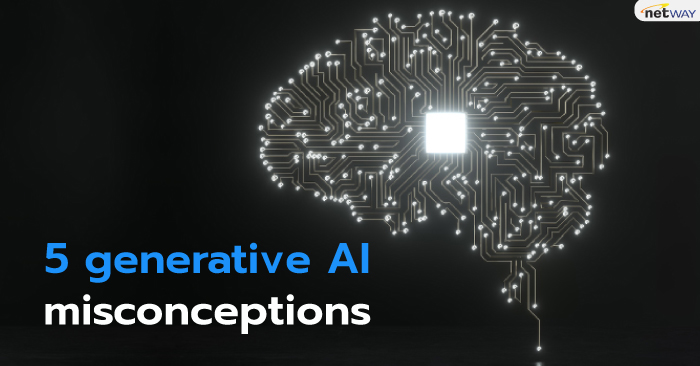-
Welcome to My Website
This is a text box. Write your own content here. This is an excellent place for you to add a paragraph.
5 generative AI misconceptions

5 generative AI misconceptions

Stay up to speed on transformative trends in generative AI

Misconception 1: One model to rule them all
It is a myth that a single defining large language model (LLM) or other type of generative AI model will define all use cases.
Many corners of the technology market have come to be defined by a handful of companies. The nature of generative AI, especially for enterprises, suggests we will be looking at thousands of models or more.
The reasons vary, but it is already clear that some models are good at summarization, others are good at bulleted lists, others are good at reasoning, and so forth. Industries, lines of business, and companies have very different editorial tones for expression of knowledge. All these should be considered when choosing your models.
Misconception 2: Bigger is better
Generative AI models consume large amounts of computing resources. The large funding rounds required for companies creating foundation models is just one testament to these costs.
Potentially high compute costs are one reason why using the right model for the job is so important. The larger the model, the more it costs to query.
Your enterprise model doesn’t need to know the words to every Taylor Swift song to generate a summary report on next quarter’s sales goals by region. Context is king and you need to be selective in just how much IQ a model requires for your use case.
Misconception 3: Just me and my bot
Just as past “bring your own device” and “bring your own app” movements raised “shadow IT” concerns, some financial institutions I work with have shut down access to publicly available generative AI for fear that models could leak proprietary information.
Some public generative AI services may leverage user data for future training sets, potentially exposing proprietary data. Let’s say a bank is exploring a merger for a large industrial client, and someone in the M&A department queries a public model, asking, “What are some good takeover targets for XYZ Industries?” If that information contributes to the model’s training data, the service could become trained to answer this question for anyone. By default, Google Cloud AI services do not use private data in this way.
Most customers I speak to are worried about the security of the questions they ask models, the content they train on, and their models’ outputs. And they probably should be.
Misconception 4: No questions asked
The accuracy and reliability of generative AI has been one of the biggest topics around the new technology. An algorithm is designed to give an answer no matter what, and in some cases, generative AI models can produce answers that aren’t true.
Every company I know has deeply invested in creating verifiable facts and data. It’s essential for enterprise customers to use models and a technology architecture that is grounded in the factuality of their data.
Most generative AI models punt on this enterprise data requirement. It is essential, especially in regulated industries, to not punt.
Misconception 5: Ask me any question?
Enterprise customers have many information sources: pricing, HR, legal, finance, etc. But I dont know of any company that allows open access to all of this information.
Some business leaders are increasingly interested in building all their information into a large language model, so it can conceivably answer all questions, whether that’s at the organizational level or the global level.
After a company thinks through how they can keep their information private and factual, they quickly realize the next step: How do I manage who can ask questions of my models, and at what level?
" Some business leaders are interested in building their information into an LLM, so it can conceivably answer all questions, whether at the organizational level or the global level. "
บทความในส่วนนี้
-
ฟีเจอร์ Google AI ใน Google Meet และ Google Chat
Updated on 2025-04-03 04:15:37
-
Google AI ได้รวมอยู่ใน Workspace Plans แล้ว
Updated on 2025-03-28 08:59:28
-
การปรับราคาบริการ Google Workspace (ตั้งแต่ 17 มี.ค. 2568)
Updated on 2025-02-21 05:11:36
-
เคล็ดลับการจัดระเบียบที่เก็บข้อมูลบนคลาวด์เมื่อใช้ร่วมกัน
Updated on 2024-08-21 03:54:49
-
Google เข้มเรื่องความปลอดภัยของเว็บไซต์ กระทบ Entrust และ AffirmTrust SSL Certificate
Updated on 2024-07-04 02:13:50
-
Google Meet เพิ่มการแปลคำบรรยายเป็นภาษาต่างๆ มากขึ้นโดยอัตโนมัติ
Updated on 2024-06-25 01:56:27

-
Domain
-
Hosting
-
Cloud & Managed
-
SSL
-
Email
- เรียนรู้เพิ่มเติม
- Microsoft 365 รุ่นต่างๆ
- Microsoft 365 สำหรับธุรกิจ
- Microsoft 365 สำหรับใช้งานที่บ้าน
- ทดลองฟรี
- G Suite
- เทคนิคลดต้นทุนอีเมล Microsoft 365 มากกว่า 28%
- เทคนิคลดต้นทุนอีเมล G Suite มากกว่า 19%
- Zimbra-Based Email
- Traditional Email by cPanel
- Physical to Cloud Migration
- Exchange Server to Microsoft 365 Migration
- G Suite to Microsoft 365 Migration
- Microsoft 365 to G Suite Migration
- Cloud to Cloud Migration
-
Microsoft
-
Google
-
Marketing
-
Others
-
Blog
-
Microsoft Teams
-
microsoft-365-business-premium
-
test-slide
-
Order
-
Promo